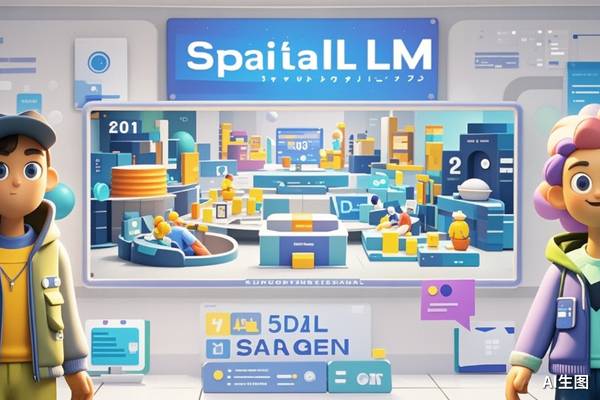On August 25th, at the first Tech Day, Qunhe Technology officially released the latest achievements of its large spatial model: the new-generation spatial language model SpatialLM 1.5 and the spatial generation model SpatialGen, and announced that it would continue its open-source strategy and gradually open the models to global developers.
As a model system focusing on 3D indoor scene cognition and generation, Qunhe’s large spatial model builds its technological advantages mainly around three directions: realistic holographic roaming, structured interaction, and complex indoor scene processing.
The newly released SpatialLM 1.5 is a spatial language model trained based on a large language model. Zhou Zihan, the chief scientist of Qunhe Technology, explained during the technical exchange that SpatialLM doesn’t add a new modality to the visual language model (VLM), but enables the large language model to learn a new “spatial language”. This language can precisely describe the spatial structure, geometric information, interrelationships, and physical parameters of objects in a scene in the form of digital text.
Through the dialogue system SpatialLM-Chat, users can input simple text instructions, and the model can automatically generate a structured 3D scene script containing physically correct information and intelligently match furniture for layout. The model can also conduct scene Q&A and editing through natural language. For example, in a live demonstration, after inputting the instruction “Go to the dining table in the living room to get medicine”, the model not only understood the object but also automatically planned an action path using tools, demonstrating its application potential in robot scenarios.
Huang Xiaohuang, the co-founder and chairman of Qunhe Technology, mentioned in his speech that a major bottleneck in the current development of spatial intelligence lies in the scarcity of 3D interactive data, especially the extremely high difficulty in obtaining indoor spatial data corresponding to the physical world. SpatialLM 1.5 can quickly and in batches generate a large number of diverse scenes that meet the requirements, which can be directly used for training in robot path planning, obstacle avoidance, and task execution, providing an effective solution to the current problem of insufficient robot training data.
Different from SpatialLM, which focuses on “understanding and interaction”, the SpatialGen model focuses on “generation and presentation”. It is a multi-view image generation model based on the diffusion model architecture, which can generate multi-view images with spatio-temporal consistency according to text, reference images, and 3D spatial layouts.
Long Tianze, the AI product director of Qunhe Technology, pointed out that current mainstream AI video generation tools learn based on 2D image sequences and lack a true understanding of 3D space and physical rules. Therefore, when switching perspectives or during complex movements, spatial logic errors such as object position offset, background chaos, and model penetration often occur.
SpatialGen generates multi-view images with consistent spatial attributes and physical relationships across different shots and can further generate 3D Gaussian (3DGS) scenes, and finally render videos that allow users to freely roam. This solution aims to fundamentally solve the current spatio-temporal consistency problem in AIGC video generation. Long Tianze revealed that the company is developing an AI video generation product that deeply integrates 3D capabilities and plans to release it within this year.
Huang Xiaohuang shared Qunhe Technology’s strategic layout for spatial intelligence at the event site. Its core is a spatial intelligence flywheel composed of “spatial editing tools – synthetic spatial data – large spatial models”. Through the wide application of tools such as CoolHome, a large amount of data is accumulated; these data are used to accelerate model training; and then the powerful model capabilities are used to improve the tool experience, thus forming a positive cycle. As of June 30, 2025, Qunhe Technology has owned more than 441 million 3D models and more than 500 million structured 3D spatial scenes.
Huang Xiaohuang said that open source is an important part of Qunhe Technology’s strategy, and the company has been gradually opening up its data and algorithm capabilities since 2018. He believes that the current large spatial model is still in its early stage, and hopes to work with global developers through open source to expand the “pie” and promote the rapid advancement of technology.
It is reported that the two models released this time will be open-sourced on platforms such as Hugging Face, GitHub, and ModelScope Community one after another. Among them, SpatialGen was available for download on the day of the Tech Day, and SpatialLM 1.5 will also be open-sourced in the form of “SpatialLM-Chat” in the future.

